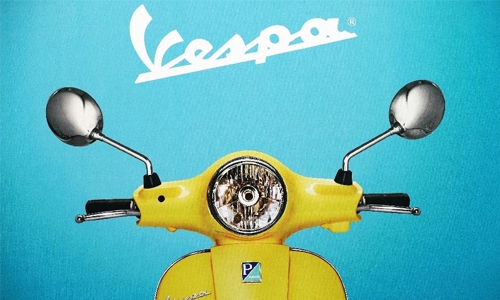Italy says happy 70th birthday to iconic scooter
Milan : Design classic and symbol of the "dolce vita", the Vespa turns 70 this weekend and Italy's most celebrated scooter is buzzing along nicely after tripling sales in the last decade.
It was on a Vespa that Gregory Peck pursued Audrey Hepburn in "Roman Holiday", the 1953 film that helped make the marque synonomous internationally with the Roman capital.
But it was actually in Florence that the wasp-shaped two-wheeler was born, Enrico Piaggio having registered the patent in the Tuscan capital on April 23, 1946.
Seventy years later, more than 18 million models have been sold and Piaggio's objective of reinventing the family aeronautical company has been realised and then some.
With the company still dealing with the damage done to its production facilities by World War II bombing, Piaggio asked one of his engineers, Corradino d'Ascanio, to create a motorcycle that would be both easy to produce from the materials at hand and inexpensive for consumers.
The simple brief proved inspired, as did the choice of d'Ascanio, who never made any secret of the fact that he found the motorbikes of the time uncomfortable, cumbersome and dirty.
The engineer addressed each issue one by one and the result was a scooter with a revolutionary design that remains barely untouched to this day.
It was an instant success. From sales of 2,284 in 1946, annual production increased to nearly 20,000 within two years, and to 60,000 in 1950.
By the mid-50s sales had tripled again and Vespas were being manufactured in 13 countries.
- Retro style -
"The Vespa was better than a motor bike: it had a body with a front apron that protected riders from dust, the mud and the rain," said Patrice Verges, a historian of the automobile industry.
"It had small wheels which made it possible to carry a spare with you at a time when punctures were a regular hazard because of nails dropping off horseshoes.
"And people liked the design and the distinctive noise, which was like that of a wasp."
People also liked the price. "In the 1950s and 1960s, you bought a Vespa because you could not afford a car," added Verges.
As the Italian economy began to boom in the 1980s, life got tougher for the manufacturer.
Obligatory helmets made the riding experience safer but less romantic and families were able to opt for cars as their main means of getting about.
Since 2004 however the brand has been undergoing a worldwide revival thanks to a combination of enthusiasm for the Vespa's retro style and its utility for moving quickly around increasingly congested cities.
From 58,000 units in 2004, production, now concentrated in Italy, Vietnam and India, reached nearly 170,000 last year and the allure of the Vespa brand means Piaggio can command higher prices than rivals.
"The Vespa is still a legend," is how Marco Lambri, the current design director, puts it. "It represents the best of Italian design and the (engineering) genius that allowed aeronautical technology to be applied to the creation of a scooter that has revolutionised our way of getting around."
Marketing manager Davide Zanoli adds: "It is not just a vehicle, it is an icon of Italian style, elegant and irreverent at the same time."
To celebrate the 70th birthday hundreds of Vespa aficionados will gather this weekend at Pontedera near Pisa, where the scooter has been produced continuously since 1946.
Among them will be Carlo Bozzetti, president of the Vespa Club of Milan and proud owner of six different models from different eras.
"I use one every day, for work, holidays and leisure," said the 59-year-old. "The Vespa has been part of my life for 40 years."
Related Posts

